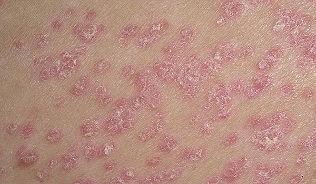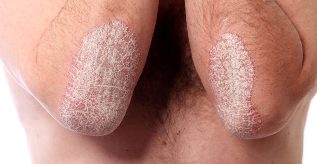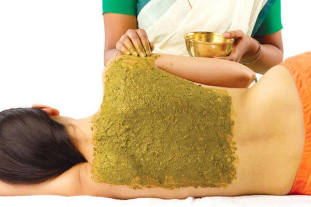Clashing with psoriasis, many patients do not once you recognize the disease, keeping precipitation reactions and some other dermatitis. For a timely diagnosis of the disease is important to know how is the pathology, what are the stages of psoriasis, and the manifestations of the disease in different stages. The course of psoriasis is characterized by four phases, among which highlight the initial, progressive, stationary phase, and a phase of retreat. In more detail each of the phases considered in the article.
The initial phase of psoriasis

Many people are interested in what it looks like psoriasis in the initial phase? See the first manifestations of the disease may be in the picture. For this phase, a peculiar growth on the skin characteristic red, pink spots with clear boundaries. The disease can occur in different parts of the body. Below that come the photo of pathology for different parts of the body.
The symptoms of psoriasis in the initial phase
For the initial phase of the disease, characterized by the following symptoms:
- slight desquamation of the dermis;
- redness of the skin;
- the development of itching;
- the feeling of dryness, tightness;
- the formation of spots of various diameters;
- gradual increase of the peeling.
The clinical picture of the disease can vary depending on the type of disease. So, in psoriasis, in the form of drops, the size of the platelets is a small diameter, not more than 2 — 3 mm. the most popular form, the vernacular, rashes reach considerable size, more than 5 cm, often merge among themselves, forming a large lake. For pustular psoriasis special training and on the dermis, and the crust is colored yellow or grey with an accumulation of serous fluid under them.
The initial phase lasts in each patient in a different way. This depends on the type, the immunity of the patient, and other characteristics of an organism.
The initial treatment
For the early stages of the disease is often prescribed for the local treatment of skin rashes with the use of ointments, gels, lotions. Medical therapy is directed to eliminate the itching, flaking, swelling, redness, inflammation. To do this, the use of hormonal and non-hormonal ointment.
Hormonal drugs in the initial phase of nominate rarely. Often their use is indicated for patients with acute in the course of the disease.
Hormonal ointment often cause side-effects. We recommend that you use them only on doctor's prescription.
Progressive stage of psoriasis

The progressive phase characterized by an increase of the manifestations of the disease, platelets are more and more, itching, flaking, edema, inflammation is improved. Rashes begin to merge with each other, affecting significant areas of the dermis. In the phase of progress often appears to have this symptom, as a phenomenon kebnera. The essence of the phenomenon lies in the fact that the new skin rashes appear in places with skin damage. If on skin there are scratches, abrasions, burns, in their place, with great probability, appear in the plates. Duration phase of progress lasts, on average, from 14 days up to several months. Every patient has this amount of time depends on the individual and how quickly the immunity to manage the disease.
Treatment progressive phase of
Acute psoriasis requires an integrated approach using the following methods:
- The pharmacological treatment.
- The use of physiotherapy.
- The correction of the life style of the patient.
Important! The tactics of individual treatment for each patient depends on the severity of the disease, the characteristics of the flow and the presence of complications.
Drugs
To get rid of plaque and reduce the symptoms of the disease in clinical practice, using the following groups of drugs:
- Antihistamines – calculated on the reduction of such manifestations, such as itching, redness.
- Sedatives – used to remove excess nervous tension, normalize the sleep.
- Anti-inflammatory non-steroidal – safe, relieve the inflammatory process, helping to eliminate redness and other signs of disease.
- Diuretics medicines, which are calculated on the excretion from the body excess fluids and salt. These medicines help to purify the body, which has a positive influence on the course of the disease.
- Keratolytic – promote good desquamation of the epidermis, make the regeneration of the dermis, the its update.
- Immunomodulatory – regulate the immune system of a person, which is an important condition of healing.
- Hormonal masi – give a fast result, you use it mainly for a serious illness.
- Cytostatic – have the property of inhibiting the immune system, it is sometimes necessary to get rid of error psoriatic platelets.
All the medications should be used only and exclusively after the appointment of a doctor. Self-medication only to aggravate the disease.
Physiotherapy treatment
Methods of physiotherapy refers:
- PUVA-therapy;
- The use of ultrasonic radiation.
- The magnetic therapy.
- Therapy.
- The laser beams.
- The mud bath.
- Paraffin and.
- Treatments in the spa.
The number of sessions and their duration, collects doctor, given the characteristics and the type of disease, but also personal qualities and the general health of the patient.
The traditional methods

Of the popular treatment methods are recommended:
- Natural oils (juniper, or lavender). Have a healing and soothing effect, a beneficial effect on the skin. How to use: add a few drops of oil in the cream and dotted apply on the precipitation.
- Hydrogen peroxide (3%). Is applied and not washed. Before application it is necessary to consult a dermatologist.
- 30 g of propolis, mix it with 250 ml of vegetable oil (oil of pre-boil). The cooked mixture must be applied to dissolve the stratum corneum of the epidermis and restore the elasticity of the skin.
- Beeswax. This product has anti-inflammatory properties and mitigating effect. Bees wax you need to melt in a water bath, after which apply it gently on the crust, covers papules.
- The honey. The main waste product of the bees, the positive effect on the human body for psoriasis. His need to be eaten in limited quantities – 2 tablespoons per day.
Infused against psoriasis
Of the popular treatment methods all used the same oil and hydrogen peroxide.
You can add a dye to the base of the celandine. For its preparation will need 3 tablespoons of this plant (dry or fresh) and salt water. In any case, you can use the alcohol, as it can dry out the skin.
How to prepare a remedy:
- the components you need to mix between them;
- leave for a couple of hours.
Before applying the tincture of the skin, it is recommended that you anoint the beech tar (lc), in order to strengthen the curative effect.
The therapy has been effective, the patient must switch to diet food, foods harmful result in a worsening of the condition.
The diet in psoriasis

Patients with psoriasis, it is important to follow a proper diet. The diet allows you to clean the skin from platelets, prevent a complication of the disease.
Principles of clinical nutrition the following:
- It is necessary to abandon spicy, salty, sour, fried. These products only increase the growth of the platelets.
- The diet should be saturated a lot of vegetables, fruit.
- As a main dish it is best to choose cereals, soups, lean fish and meat.
- On the table should not be present in product allergens. It is necessary to abandon the eggs, nuts, chocolate, citrus fruits.
- Caffeine-containing beverages are also excluded.
- Is prohibited alcohol, carbonated drinks.
- Dairy products should not contain fat. Preference should be given yogurt without additives, kefir, milk.
Take the food you recommend small portions, and avoid overeating. The diet is an important component of the therapy of the disease. A proper diet helps to saturate the body with vitamins, to get rid of waste and toxins.
Fixed stage
Fixed a stage characterized by a decline in the growth psoriatic platelets, their number on the body does not decrease, the disease, as it goes to sleep. In the presence of factors triggering the disease from a standstill can move again in a phase of progress. The causes of this phenomenon becomes wrong treatment, the refusal to comply with the diet, lesions of the skin. The duration of the stationary phase is so different in different patients, which is rather difficult to hypothesize its borders. On average, this moment lasts from a few weeks to several years.
The phase of regression
The phase of regression is the final step before remission of the disease. Here they celebrate the following changes:
- Colour papules of red color enters in a pale, pink hue.
- Decreases the number of peeling.
- Goes itching.
- The skin is clean, acquires the hue and the structure.
- When on some parts of the body are the so-called "ordinary plates". These rashes completely do not pass, they are saved on the skin, even in a period of remission.
Psoriasis refers to a chronic dermatitis, non-infectious. Completely get rid of the disease that was impossible until today. The patients who have the disease, it is necessary for all life to adhere to the activities of prevention, aimed at preventing relapse. Many patients can save a period of remission for years to come, to lead a complete life style.























